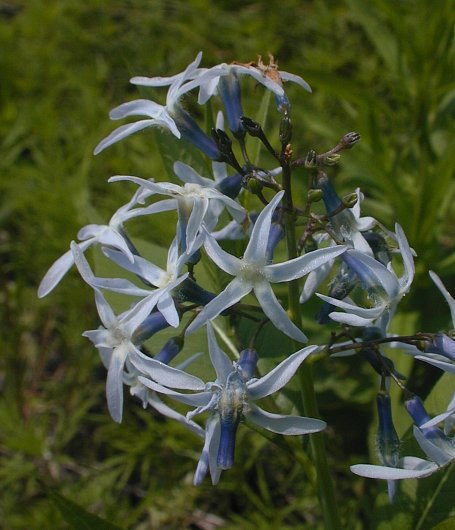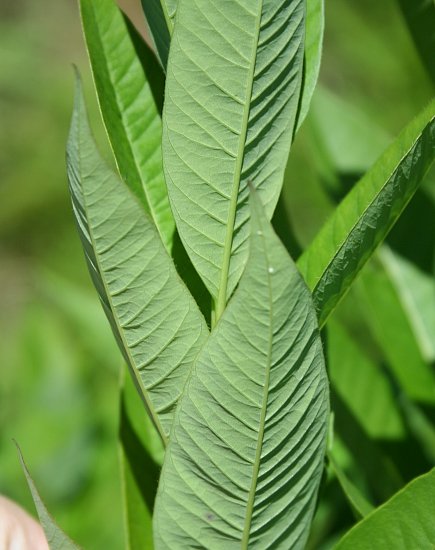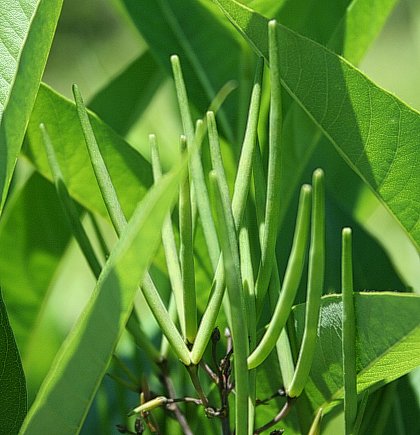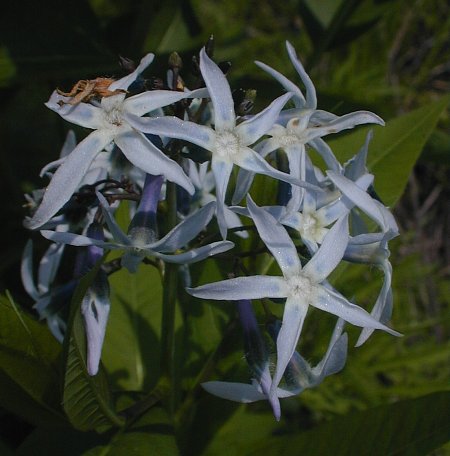Description: This herbaceous perennial wildflower is about 2-4' tall; in open areas, it usually branches and has a bushy appearance. The stems are light green, terete, glabrous, and glaucous. The alternate leaves are up to 6" long and 2½" across; they are ovate to narrowly ovate, smooth along the margins, and usually hairless. The upper surface of each leaf is bright green, and glabrous, while the lower surface is pale green. Rarely, the lower surfaces of the leaves are pubescent. Each leaf has a slender petiole up to 1" long. The upper stems terminate in compact panicles of flowers.

Each flower spans ½–¾" across, consisting of a tubular corolla with 5 widely spreading lobes and a very short calyx with 5 triangular teeth. The corolla is mostly pale blue and its lobes are narrow and star-like. Near the base of each lobe, there is a small patch of white or pale yellow. The narrow throat of each corolla is guarded by a ring of white hairs that face inward (probably to keep out ants & other nectar thieves). The branches of the panicle are green and hairless, becoming dark brown or black with age. The blooming period occurs from mid-spring to early summer and lasts about a month. There is no noticeable floral scent. Each fertilized flower is replaced by a pair of cylindrical follicles that are about 4-5" long. The follicles are glabrous and erect to ascending. Each follicle contains a a single row of small cylindrical seeds; it splits along one side to release them. The root system consists of a taproot. This wildflower spreads by reseeding itself.

Cultivation:
The
preference is full sun to light shade and moist conditions. Different
soil types are tolerated, including those that contain clay-loam, rocky
material, or sand. The foliage is rarely disfigured by herbivores or
disease. More flowers are produced if there is some exposure to the sun.
Range & Habitat:
The native Bluestar is occasional in southern and western Illinois; it
is absent
elsewhere (see Distribution
Map). Habitats include rocky woodlands, shaded rocky ravines,
gravelly seeps, borders of streams, limestone glades, and moist sandy
meadows. Because of its attractive foliage and flowers, Bluestar is
occasionally cultivated in gardens, from which it can escape. This is
the only native Amsonia sp. in Illinois; other
species in this genus are native to areas south of Illinois.

Faunal
Associations:
The nectar of the flowers attracts the Ruby-throated Hummingbird and
various long-tongued insects. These insect visitors include the Large
Carpenter Bee (Xylocopa virginica), Hummingbird
moths (Hemaris spp.), and various butterflies. An
aphid, Macchiatiella
rhamni, uses Bluestar as a summer host (Hottes &
Frison, 1931). Because the foliage contains a white latex that is
toxic, it is avoided by mammalian herbivores.
Photographic Location:
A wet prairie at Meadowbrook Park in Urbana, Illinois.

Comments: The star-like flowers are a heavenly shade of light blue and the foliage is an attractive bright green. No other native plant in Illinois resembles this species. The closest relatives of Bluestar in Illinois are Apocynum cannabinum (Common Dogbane) and Apocynum androsaemifolium (Spreading Dogbane). These latter two species have white to pinkish white flowers that are bell-shaped and smaller in size. While Bluestar has alternate leaves, Common Dogbane and Spreading Dogbane have opposite leaves. Sometimes other Amsonia spp. (Bluestars) are occasionally cultivated in gardens. They differ from the Bluestar that is described here by the shapes of their flowers and leaves. Another common name of Amsonia tabernaemontana is Blue Dogbane.